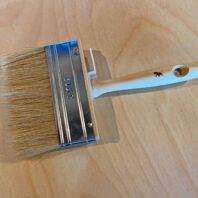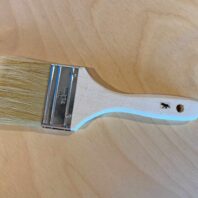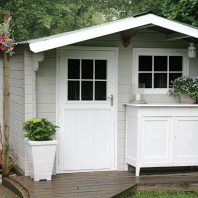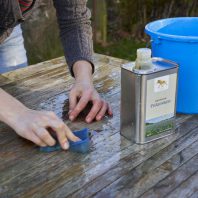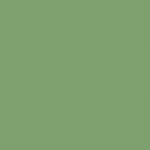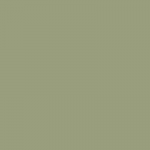Painting a shed | How to go about it?
Do you want to paint your wooden shed? Moose Färg’s Swedish wood stain is a smart choice. Why? We are happy to explain.
Wooden sheds are often made of Douglas-, spruce- or pine wood. Or in other words, wood varieties that “work” because of humidity and temperature differences. The wood shrinks and expands. This means the paint has to meet special requirements. After all, you don’t want the paint layer to crack and flake off.
Moose Färg is designed especially for painting your shed: easy to use, low maintenance and no sanding between coats.
On this page you’ll find:
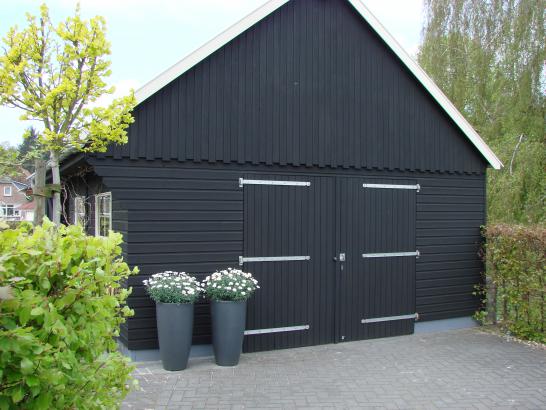
Do you want to get started right away?
Why paint your shed with Moose F?
Conventional wood paint forms a sealing film layer on the wood of your shed. As the wood shrinks and expands, even the best elastic paint will peel over time. Moose Färg is made for this type of wood. In Sweden, it has been used for centuries as a practical, beautiful and affordable solution for large wooden surfaces such as sheds and houses.
- Soaks into the wood, eliminating the risk of flaking
- Has an environmentally friendly composition
- After application, you will be maintenance-free for about five years
- Has a lively appearance: wood grains remain clearly visible
- Read more about the unique features of Moose F wood paint
Is your shed somewhat older and weathered? Then painting with Moose F is no problem either. The full-coverage paint ensures that colour differences in the wood disappear. Clean the wood with a soapy solution of Polarsken wood soap, e.g. with a brush or high-pressure cleaner. You can start painting while the wood is still wet.
Alexandra: ‘This ugly shed was an eyesore but with the Moose Färg paint it turned into a nice shed after all. What a great paint this is. It’s painted with Swedish blue and only done twice and even the colour difference in the boards can’t be seen anymore.’ (translated from Dutch)
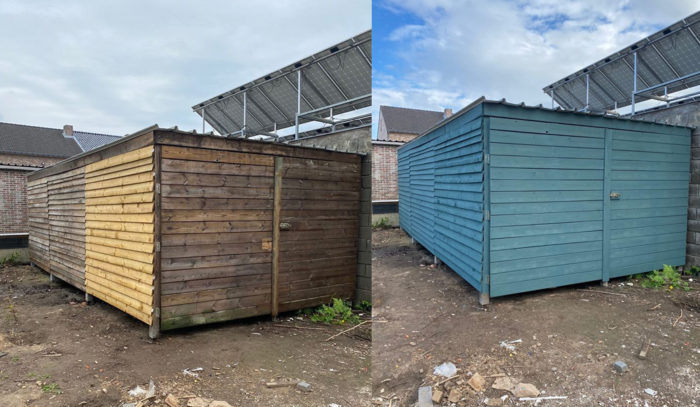
A step-by-step plan for painting your shed with Moose Färg
- Shed made of new and impregnated wood: pre-treatment
If your shed is made of new and/or impregnated wood, give it some time to breathe. The impregnating substances, which can give greenish or brown stains, will have time to leave the wood.
The wood will still shrink and expand, causing small cracks.
However, it is possible to put one layer of paint on the wood, if you prefer to do so. Because Moose Färg paint is vapour permeable, the impregnation can still come through the paint. A few months later, you can apply the second coat. Smooth planed wood should be sanded with a coarse grit (80-grit paper). This is not necessary for rough and sawn wood.
Tip: If you still have to assemble the shed, it is wise to paint the tongue and groove first (and possibly put a first thin layer over the wood). This preserves the tongue and groove best. Also remember to coat your nails with linseed oil. That prevents rusting and moisture penetration, even if you are working with stainless steel nails. And especially if you do not hammer the nails, but shoot them into the wood. Nail guns create a larger hole and it is wise to fill that. - Repainting a painted or stained shed: pre-treatment
An already stained barn can be painted with Moose F provided the surface is properly preppared. Clean and degrease the wood thoroughly. This can be done, for instance, with a high-pressure cleaner and Polarsken linseed oil soap. Use the spray mode so that you don’t damage the wood structure and take care not to spray into the insulation.
If there is a layer of paint on the surface that might flake, you will have to remove it. Coarsely sand glossy surfaces with 80-grit paper. Sanded paint residues are not a problem.
The common rumour that water-based paint cannot be used over solvent-based paint is incorrect. It depends enormously on the paint types whether they tolerate each other. For the most part, Moose F paint is perfectly usable provided the pre-treatment is done properly. - Painting
Paint the first layer with water-thinned paint (approx. 10%). Use a block brush so you can get into the cracks and crannies. Put the second layer on after the first layer has thoroughly dried. On a nice and sunny day it may take as little as 2 hours, but it can take up to 3 days, depending on the temperature etc. Here, you’ll read more on drying time. If you apply the second layer and the paint hasn’t properly dried yet, you’ll notice that the first layer will come off.
Primer is not necessary, Moose F is its own primer. Do not sand between coats, that is not necessary and even undesirable. - Maintenance
At the end of the season or after winter, check the paintwork. The paint soaks into the surface and you may not have hit all areas thoroughly. You can then touch up locally or just lightly brush over the entire surface, which will not be visible and will ensure optimal results for years to come.
Products you need to paint your shed:
What colour is your shed going to be?
Moose Färg paint is available in 19 unique matt colours from the Swedish colour palette. Would you like a different colour? We can mix them for you. In that case, order via ‘customer colour’ and specify a RAL or NCS code to us via the order notes.
In the Swedish tradition, a striking colour (a black or a red shed) is often combined with white. The contrast with white enhances the colour even more. Curious about what Moose Färg colour combinations look like? Create your own colour combinations with our colour tool.
Maintenance of your painted shed
Maintaining your shed painted with Moose Färg paint is incredibly simple. You don’t actually have to do anything. When rain or wind make your shed dirty, you can clean it with water (and if necessary wood soap). Depending on the conditions, your shed will remain beautiful for about 5 years. It weathers faster in bright sunlight than in the shade.
When repainting, there is no need to sand. Just clean it thoroughly and apply a new, thin layer. You could also do this locally in places where maintenance is required. Due to the completely matt nature of the paint, you will not see this when the paint dries.
Ebgert and Lydia: ‘Cleaned our stained shed with linseed oil soap, sanded it and painted it with Moose F lead grey and Moose RDM snow white. We did not expect this result. Wonderful paint to work with and a beautiful result.’ (translated from Dutch)
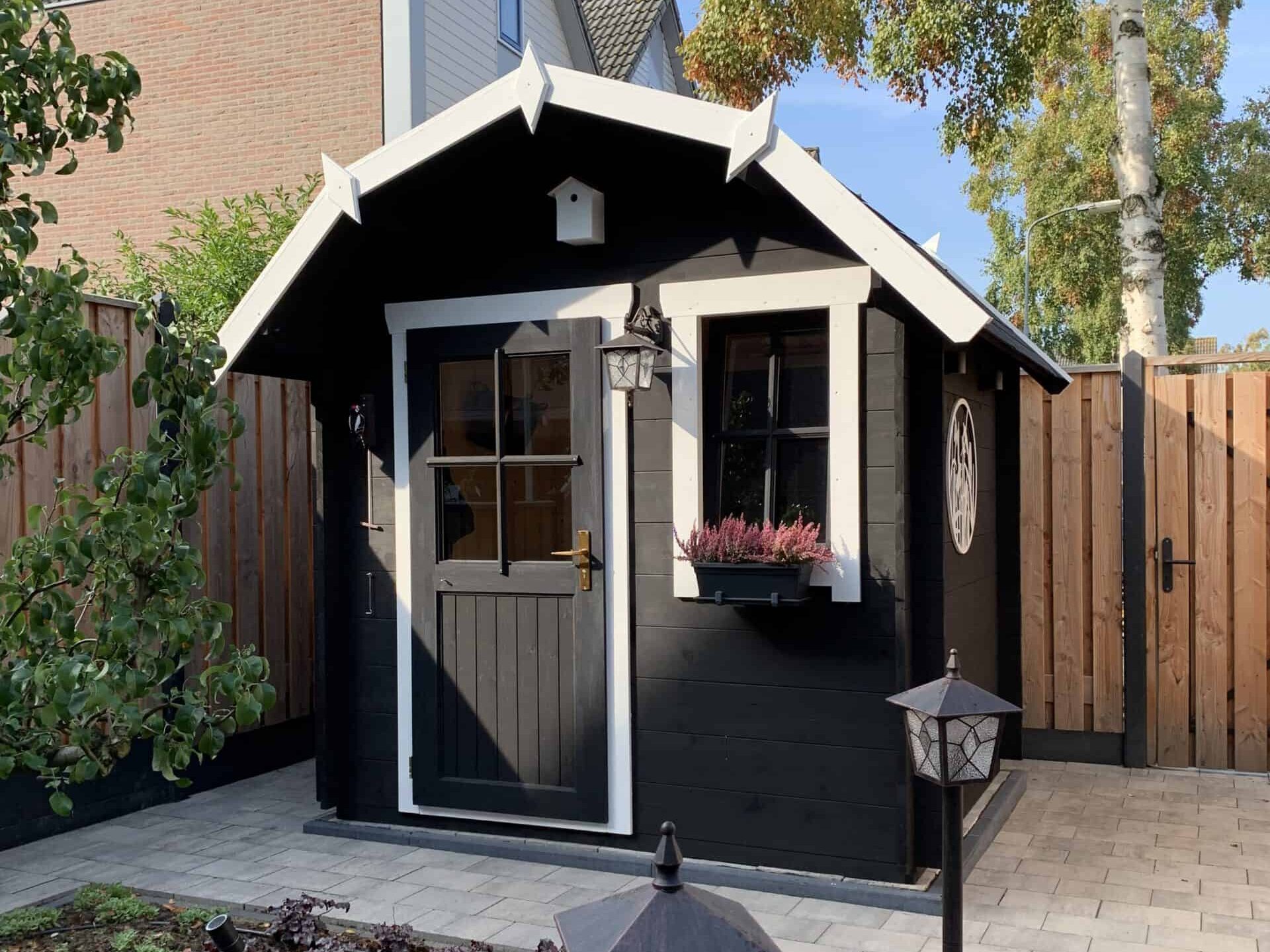
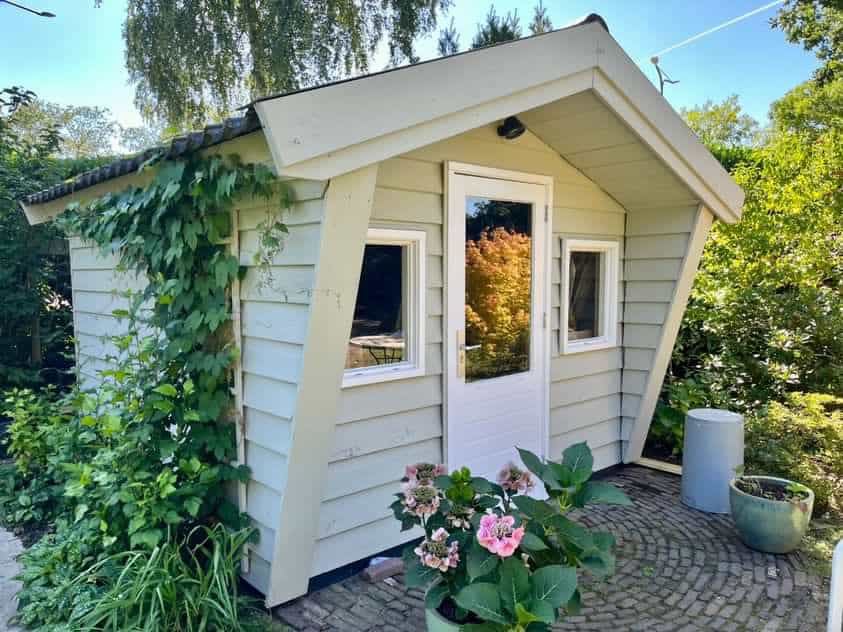
Preventing mould and mildew
When you are going to paint your shed, make sure you treat it against mildew when necessary. Mildew is a mould commonly found in sheds and is caused by moisture. To effectively combat mildew, use an anti-fungal agent. Treat the wood before and after painting. Since moisture causes fungal growth in your shed, it is wise to check the construction of your shed and its ventilation.
Tip: You could add a small amount of the anti-fungal agent to the paint.
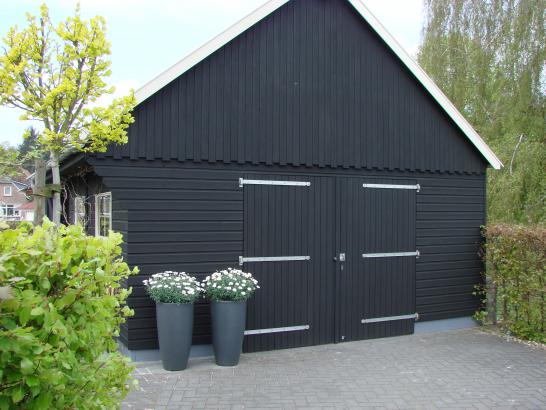
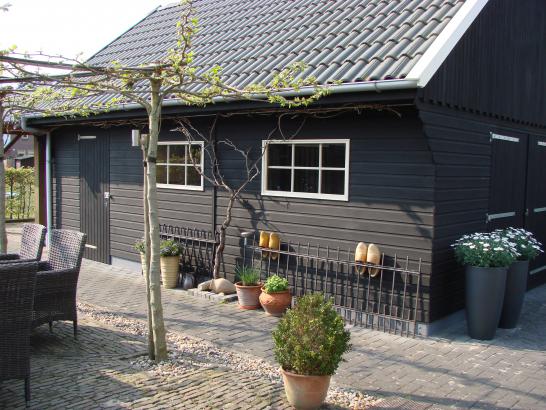
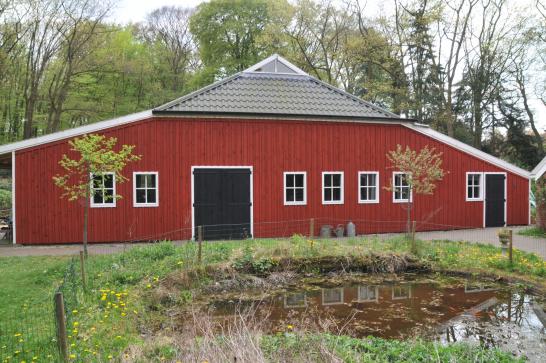
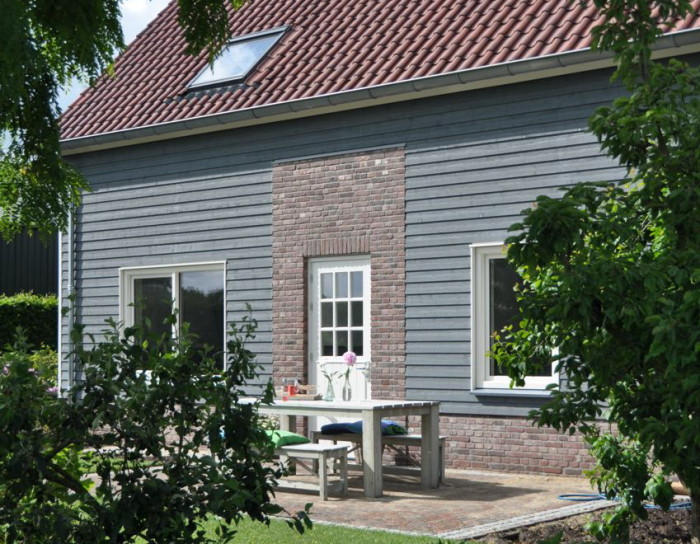
FAQ on how to paint a shed
This is possible, but not required. Because Moose Färg soaks into the wood, the wood can release its moisture. Because of this, the wood will not warp when you paint only one side, unlike lacquer paints. You can still choose to paint the inside of your shed to give it extra protection or because you like the look of it. You can do this with an opaque stain, but you could also choose a Dimma wash effect or a transparent impregnation.
Yes! You can think of our black stain as an eco-friendly replacement for black tar. Tar (or carbolineum) used to be a very popular agent to make sheds damp and waterproof. However, it has been banned for years because of the carcinogenic substances in coal tar. The processing of tar was also not ideal because it becomes hard at lower temperatures and soft at high temperatures. So you could only apply it when it was hot, and the tar dripped off the shed when the sun shone very brightly.
A water-based black stain like Moose F is an excellent eco-friendly alternative to tar/carbolineum. The effect is different because the paint soaks into the wood and does not stay on it. This ensures that the wood continues to breathe and you don’t have to repaint every year. Moose Färg stain is water-repellent (drops slide off) and conserving. However, the colour is just as deep and there are no harmful substances in the paint.
Wood pre-treatment depends on several factors. You do not need to sand roughly sawn wood that has not been impregnated. The raw wood actually absorbs the paint wonderfully. Planed wood requires some sanding before painting. When your shed has been painted before, the paint should be removed when it is flaking or can flake. This can be done by sanding, but also with a high-pressure cleaner or a heat gun. You never need to sand between two layers of Moose Färg. Nor do you need to sand when repainting Moose Färg.
Yes, if the carbolineum is already somewhat weathered, you can paint over it with Moose F. Make sure that you clean wood treated with carbolineum thoroughly. You could, for example, use a soapy solution of organic wood soap Polarsken and a pressure washer on the spray setting. Then use a block brush to paint the first layer with diluted paint (about 10%), so that you get into all the nooks and crannies. Apply the second layer after the first layer has dried thoroughly. Primer is not necessary and you don’t need to sand between coats. With Moose F Vasa Svart (black stain) you can paint your shed a beautiful deep black.
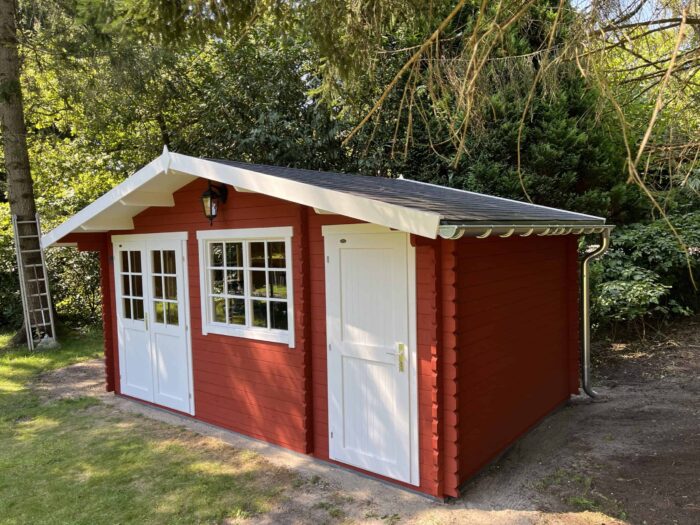
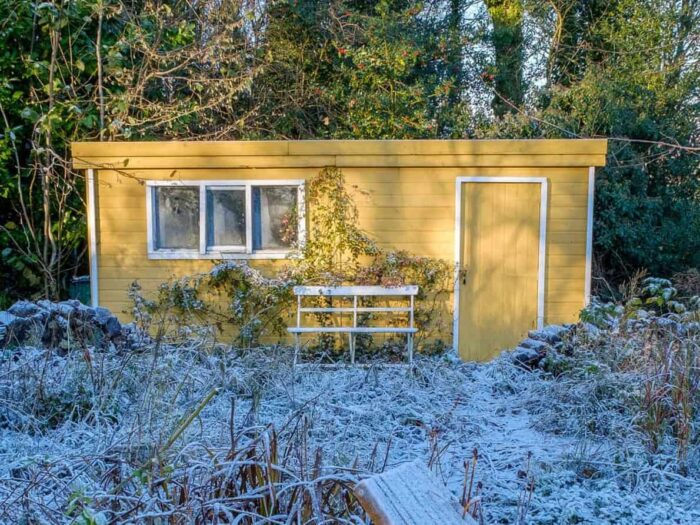
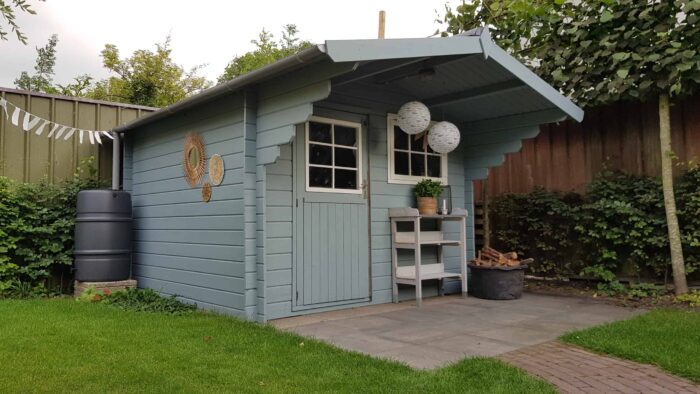
Would you like additional, personal advice?
We are happy to help. Send an e-mail or call +31(0) 6 55 333 165. Watch our Instruction Video for more information. Apply here for a free color-card.


